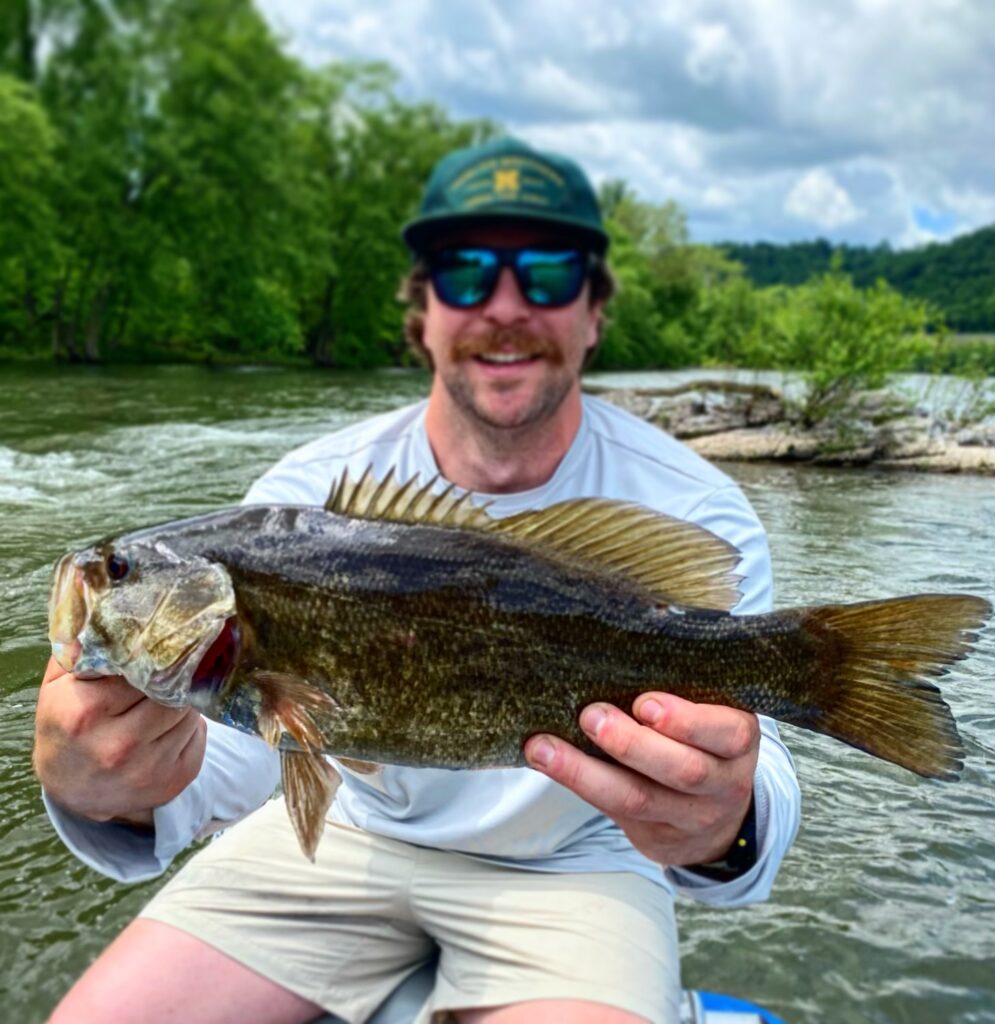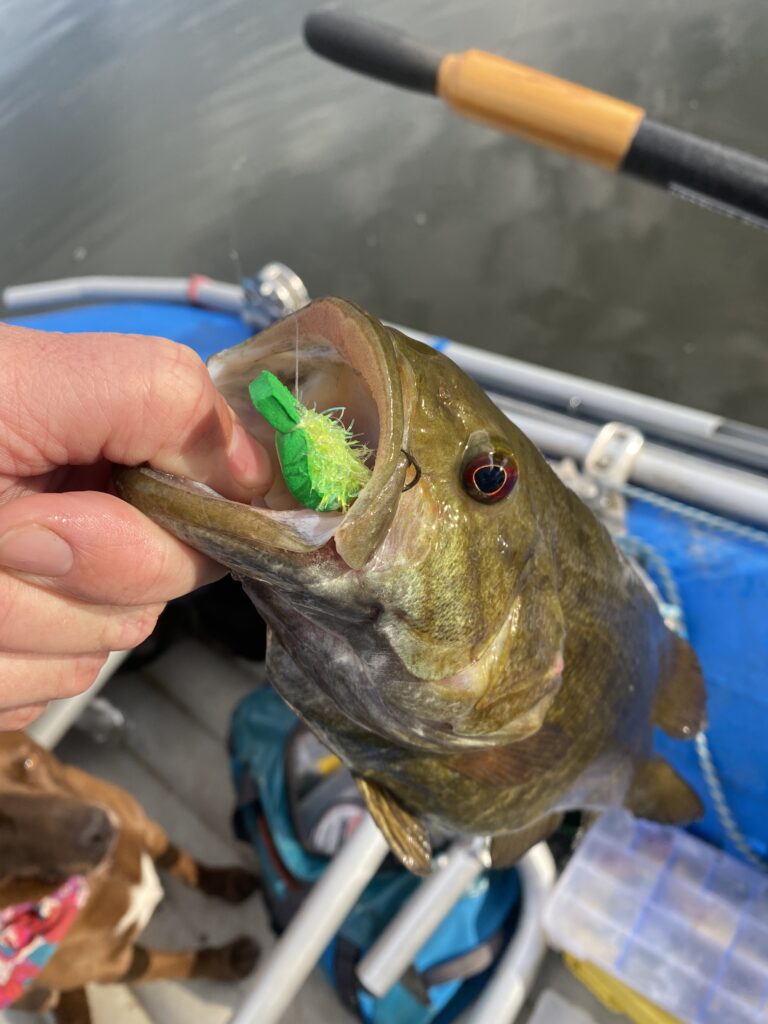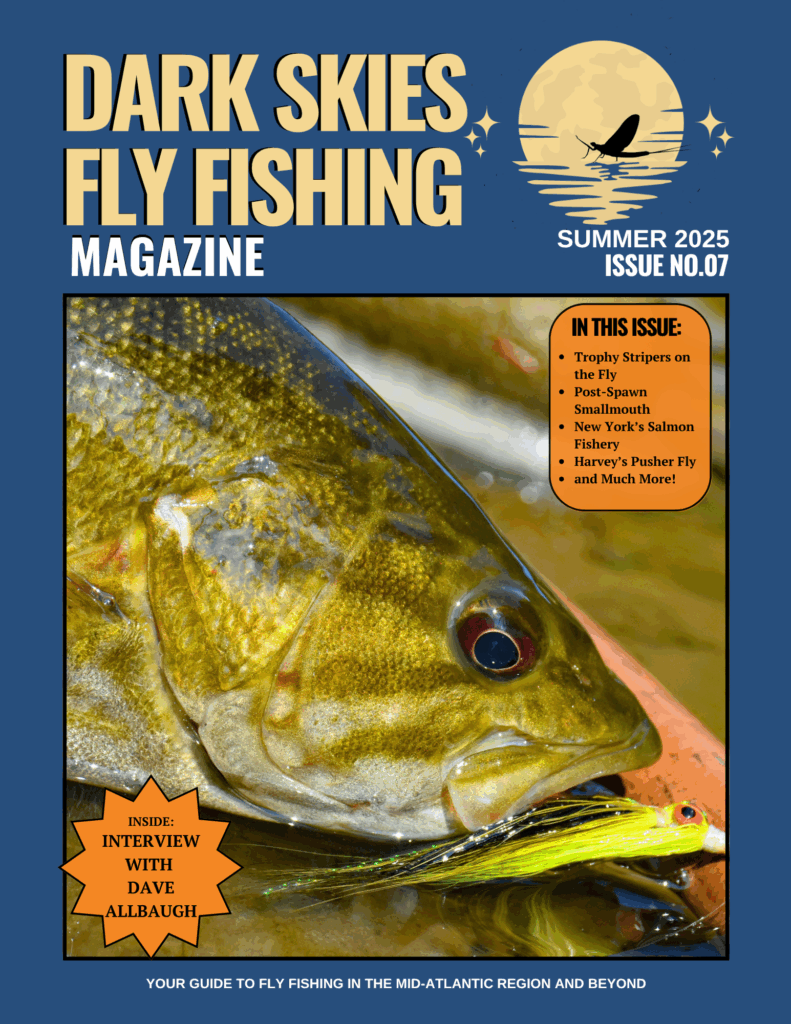Bass on the Fly: Locating Smallmouths Post-Spawn into Summer

As the rivers of the northeast warm, we see quite the transition in smallmouth behavior. Understanding the when and where of smallmouth can be difficult, especially in the late spring into summer transition. There are so many variables that dictate the “when and where” and the difference between a three fish day and thirty fish day.
As we discuss these changes, it’s important to stay in tune with the specific river you are fishing. The rivers of Pennsylvania and the Northeast as a whole are generally vary in temperature which impacts the timing of spring and early summer migrations. With a solid foundation of where smallmouth spend their days at different times of the year, it will give you the tools to up your smallmouth game for the better this summer.
Smallmouth Transitions
To get a better idea of where smallmouth spend their time, we must look at where they begin every season: in their winter lies. Winter bass are simple yet difficult at times to target on the fly. However, when you find them, you normally find more than a few.
Winter smallmouth generally reside in deeper water. “Deep water” in winter refers to water 4 feet or greater. Fish will find pockets in current breaks and in submerged shelf systems adjacent to slow current. Bass have to feed at some point during winter, so they need to be close to some form of current to bring them food. Otherwise, bass will not move far during the cold months. Fish generally stay in these areas until the water climbs into the upper 40s – I start to expect some fish transitioning out of these spots during the warmest parts of the day around 48 degrees.
Following the climb into spring water temps, between 48 and 50 degrees, fish start leaving their winter homes. Smallies will find isolated structure like submerged boulders, submerged logs, and bank structure like riprap or blowdowns. Near and within smaller tributaries to large rivers are areas of opportunity for smallmouth to find food, structure, and a place to nest. These become prime ambush points during a rather voracious feeding window.
Once temperatures climb and stay between 50 and 55 degrees, smallmouth will begin preparing nests and feeding heavily. Once the water breaks 60 degrees, bass will actively spawn up to 70 degrees and the males begin guarding nests. The larger females recede back to a location of comfort and recover after spawning. I would like to give a specific week or time of month that this begins to happen, but it is a temperature dependent event rather than a calendar event. In my experiences, I have seen fish completely done spawning on some stretches of a river in mid/late May, and have seen different sections of the same river with some fish spawning into June. Note these changes in water temps in your local river, and you’ll have a good idea of what phase the smallmouth will be in.

Post Spawn Bass Behavior
For a few weeks directly following when most smallmouth spawn, fishing can become difficult, especially for larger fish. Following the spawn, males guard nests for a number of days or weeks and feed fairly little throughout the days. Females retreat to waters that provide safety and comfort, where they feed fairly little as well. Some fish may take just days to recover, where some may take a week or more to fully turn back on into feeding mode.
As the temperature maintains in the mid 60s, fish will become more active. Most sources show that water temps from 69 degrees to 79 degrees are optimal for smallmouth. The transition into summer will generally see fish distributed evenly in a river system as the water warms to 70 or higher. Fish will settle into a multitude of different types of water. We’ve located bass in deep runs, shallow grass beds, and shoals with just a foot of water. My opinion is that a smallmouth’s choice in summer water is dictated by food availability, competition, sunlight, and water temperature. This is the time to be out there. Summertime smallmouth is hard to beat.
As the dog days of summer come and go, decreases in water temperature trigger the instinct to feed and throw on the weight for winter. Bass will locate ambush locations in or near current that has great food availability. Fall can be a “second wind” for most fish before they retreat downstream into their winter holes when the water temps begin to slip into the mid 60s. Consistent cold will allow this transition to happen fast, while a warmer fall will offer opportunities until the water creeps below 60 degrees daily.
Cracking the Code
Now that we have a basic foundation of smallmouth behavior throughout the year, we can crack the code – where are the fish going during the post-spawn and the following months?
After spawning, males remain on nests to guard their young. Smallmouth fry hatch from eggs in four to five days. In water temps 70 degrees or higher, it can take 48 hours or less for fry to hatch. Female bass will then retreat to safe places, submerged current breaks, and structure suitable for hiding and resting in. Both males and females take a break from heavy feeding. We’ve now entered the “recuperation stage” of post-spawn.
The post-spawn window is a crucial time for smallmouth. While fishing during the post-spawn, there will be other fish that still have yet to spawn. We do our best to avoid fishing for nested fish and recovering fish. What we look for are the smallies that have completed their recuperation.
The late phase of post-spawn, generally in water temps in the upper 60s and through the low 70s, allow us to catch fish that have completely recovered and are now switching back into a very vigorous feeding mode which can last for up to a few days and in some instances, longer. Again, marking the transition is best done by monitoring water temperature.
The key to locating the fish during post-spawn boils down to physical location in a river. As bass retreat from their beds and complete their recuperation, they are going to occupy areas that are flushed with food. Some fish will stay in deep water. I’ve caught them in some deep areas reaching all the way down to 12 feet. I avoid fishing “dead” water and prefer to look for deep and moderate to slow current. Once these fish are ready to feed again, it’s common to pull them up into the water column with an offering of a baitfish or topwater fly.
Smallmouth that choose to leave their recuperation zones may enter moderate currents down to a couple feet of water or less, leaving the fly angler an opportunity to fish topwater flies, as well as crawfish, hellgrammite, and baitfish imitations. When choosing water post-spawn, 9 times out of 10 I am choosing to look in current to find active and feeding bass. Furthermore, structure such as riprap adjacent to moving current can and will hold actively feeding bass. Boulder fields under current are also one of my favorite locations to find recovered post-spawn fish.
Once the water reaches around 70 degrees, bass will move freely throughout the river. It’s very common to see schools or groups of bass congregating together. We refer to these as “wolf-packs”. It is not uncommon to catch multiple fish out of the same spots or see multiple fish chasing a fly. The bass seemingly fight over food, and it is a spectacle that every angler should experience and enjoy.
As the water temp climbs and stays through the 70s, newly exposed grass around islands in the middle of the river or on the banks are areas that smallmouth cruise. Watch these areas closely and you will often see small baitfish jumping. If you see this, cast as close as possible to where the bait left the water because they were just chased out by a hunting predator – more often than not, a bass.
Grass islands where grass is submerged or exposed become a prime spot for topwater. A Boogle Bug normally does the trick, but gurglers, foam bugs, and deer hair bugs work just as well.

Dog Days of Summer
As the dog days of summer settle in, most locations in the river are fair game – meaning I try to locate fish in as many water types as possible. I will fish deep runs, bank structures such as logjams and blowdowns, islands, grass, boulder fields that are exposed or submerged, and shallow shoals on a shaded bank. Fishing different water types help you gauge what water type the most active fish are in on a given day, and allows you to focus on the most productive water types.
By this point, the river temp feels like bath water which is perfect for a smallmouth’s metabolism. Seeing as smallmouth are photo-sensitive like most fish, fishing shaded areas, ambush points, and early and late in the day will give you the most success.

Fly Patterns and Gear
Topwater remains my favorite tactic through the hot months, but I do throw streamers such as Meat Whistles, Zonkers, crawdad imitations, hellgrammites, and small baitfish patterns. I rarely throw large swim flies (over 5 inches) in the summer. It’s best to focus on natural imitations, my flies rarely exceeding 3 to 4 inches in length.
When it comes to targeting bass during the post-spawn window, my selections of rods and reels remain the same – a 7wt or 8wt rods equipped with a generous weight forward taper ensure that I can turn over streamers or dense topwater patterns. Depending on water conditions, I rarely fish anything more than an intermediate tip, allowing my heavier flies to stay down where I want them without dredging the bottom.
Come summer, bass are looking everywhere for food, so I am not too concerned with getting a fly to the very bottom. Even in higher flows following a summer storm, I get away with floating lines on most occasions.
My leader setups differ depending on what I am throwing. For topwater, I fish a standard 0X or 1X tapered leader. For streamers, hellgrammites, and crawdad imitations, I use a slightly longer leader, up to 10 foot. I will use an old butt section of a tapered leader (or around 4-5 ft of butt section material) and 4 to 5 ft of 12lb down to 8lb fluorocarbon leader material. Choose your fluorocarbon wisely; I prefer something with abrasion resistance for rocky or shallow rivers with lots of structure.
Size, color, and profile are all important factors when choosing flies. Understanding your river is important, as aquatic forage can differ dramatically in different systems. In systems like the Juniata, Susquehanna, Potomac, Shenandoah, there is a ridiculous abundance of forage for bass. I normally fish the most likely spots to find fish, and cycle through patterns until something sticks.
Post-spawn and summertime bass encounter an array of forage from darters and sculpins, crawfish, small baitfish, hellgrammites, dragon and damselflies, and terrestrials such as cicadas, beetles, frogs, and even small rodents. Smallmouth are cannibals – do not look past the important colors of a black tail, green/olive back, and cream/white belly. The baby bass color combo is one to not be overlooked.
Matching the hatch may be for trout fisherman, but the concept remains the same in smallmouth fishing – match the primary forage. It can make a good day into an even better day. Smallmouth are known for gorging themselves and they often will regurgitate food while fighting them on the line. Pay attention to this. It’s free intel showing you what they’re feeding on.
While I was guiding in my early 20s on the Shenandoah and Potomac, I had a veteran guide tell me that the vent in the mouth of a smallmouth can excrete a smell that at times becomes pungent enough for us to notice. He described that a fish with a “sweet” smell in its mouth was feeding primarily on crawfish. A fish with a sour and pungent fishy smell has been eating baitfish. A fish with a neutral smell or no smell at all – well – he didn’t really help me out there. I have to be honest, I’ve only experienced this phenomenon a few times, so you may want to take this info with a grain of salt. Regardless, I’m always looking for a way to stack the cards in my deck.
Top water flies for summertime bass is the crème de la crème in my book – it’s just good clean fun. Most of my topwater offerings are hard bodied poppers. Size and color may vary, but I take more analytical approach to choosing colors. If bass are feeding on damsel flies or dragonflies, I fish a blue popper. If they are eating larger warmwater mayflies such as a hexagenia, I am fishing yellow. If I’m fishing a shaded tree bank, black and olive works tremendously. When we are finding fish mid-river, I have a lot of luck on white.
Color is never exact in these instances, but it is good to change it up often until you find a winner. When targeting fish in the early morning or before dusk, larger topwater patterns will find some fairly large fish slipping up – fish them hard in low-light hours. I’m often baffled at how shallow of water large bass will cruise in, so get aggressive and fish your larger bass bugs and poppers right on the bank.
Baitfish patterns don’t have to be complicated. I’m more focused on size and color than anything. Zonker strip patterns like a weighted Bunny Leech, a Meat Whistle, or Slumpbuster tied in natural colors tend to bring plenty of fish to hand. Black, olive, white, and gray covers most of the natural spectrum, though accents of flash or fluorescent colors like pink, chartreuse, fire orange, and red add a lot of attention to your flies.
Another fly that just seems to put numbers to the net is a Woolly Bugger with a complex twist, mixing synthetic fibers, flash, and natural materials all into one resulting in a flashy but small morsel that makes an easy meal for aggressively feeding bass.
I’ve experienced low activity at times on the water, even during what you’d think is primetime. Even through the summer, weather fronts can totally spoil a great day of fishing. Rainfall and summer storm fronts can often cause a small dip in water temps. Overnight temps that cool the water can also throw a damper on bass activity. When bass get even a degree or two of temperature change, it can affect how, where, and when they feed. Force yourself to find what they are eating, and if they’re not, force feed them.
When bass seemingly want to sit in a feeding lane and not chase food, I tend to think more like a trout fisherman. Hellgrammites are a crucial source of food for smallmouth. The way hellgrammites swim and drift in the current make them an easy protein source when the bass don’t feel like moving. Fishing hellgrammites slowly through current seams, runs, and pools will sometimes produce fish even in the worst bite windows. Similarly to trout fishing, I often dead drift hellgrammite patterns and let them swing out slowly downstream and across. Experiment with other slow moving natural imitations, or better yet, slow all of your presentations down dramatically.
As summer wanes and cooler water temps return, the transition of bass back to winter lies begins. Regardless, by this point we’ve had almost 6 months of primetime bass fishing. Understanding the pivot points in the spring and early summer migrations and transitions will help you pinpoint and locate bass all summer long.
Smallmouth bass behavior is heavily influenced by water temperatures. So, as you head out to fish your favorite river this summer, don’t forget your thermometer and don’t forget to keep your boxes full of a multitude of patterns for different situations. Smallmouth offer many fly anglers an opportunity to get on the water when trout fishing is unobtainable in the summer months. While you’re out on the water, remember to try new things, use tested methods, but most importantly, have fun out there!
___________________________________
Taylor Hess is the owner of Appalachian Fishing Guides. Visit his website to learn about incredible bass fishing opportunities in this region.
Did You Enjoy This Article?
Stay up to date with the Dark Skies Fly Fishing monthly newsletter for free and receive the latest posts in fly fishing news, tricks, tips, and techniques, stream reports, as well as updates on new flies added to the Online Store and exclusive discounts!
Sign Up NowHave a fly fishing question you’d like answered? Drop us a line at info@darkskskiesflyfishing.com! If we use your question in a blog post or in the newsletter, we’ll send you a FREE fly box with a dozen of our favorite nymphs and dry flies!



